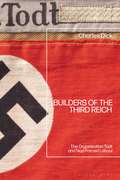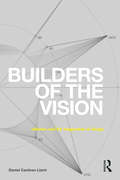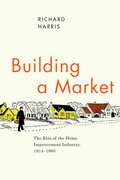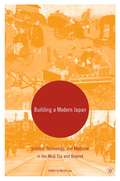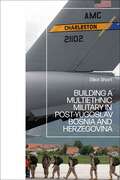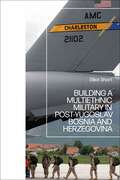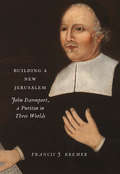- Table View
- List View
Builders of the Third Reich: The Organisation Todt and Nazi Forced Labour
by Charles DickThis is the first comprehensive critical study of the Organisation Todt (OT), a key institution which oversaw the Third Reich's vast slave labour programme together with the SS, Wehrmacht and industry. The book breaks new ground by revealing the full extent of the organisation's brutal and murderous operations across occupied Europe and in the Reich. For the first time, Charles Dick provides a strong voice for camp survivors overseen by the OT, drawing on an extensive collection of personal accounts and analysing the violence they endured.Builders of the Third Reich shows Hitler used the OT, which had a labour force of around 1.5 million people in 1944, as an instrument of subjugation and occupation to project German imperial power. Drawing on a broad range of primary sources, it demonstrates how the organisation participated in the plunder of Europe's raw materials and manpower, greatly boosting the German war economy. The book reveals how OT staff shot, beat or worked tens of thousands of prisoners to death, both within the SS-run concentration camp system and outside it, with analysis of OT operations showing that where it had sole, or very high levels of control over camps, prisoner death rates were extremely high. Examining how engineers and builders, individuals who fitted the category of 'ordinary men' as precisely as any other group so far examined by historians, perpetrated war crimes, this volume reflects on how few OT personnel were interrogated or came to trial and how the organisation passed largely under the radar of post-war prosecutors, researchers and the general public.
Builders of the Third Reich: The Organisation Todt and Nazi Forced Labour
by Charles DickThis is the first comprehensive critical study of the Organisation Todt (OT), a key institution which oversaw the Third Reich's vast slave labour programme together with the SS, Wehrmacht and industry. The book breaks new ground by revealing the full extent of the organisation's brutal and murderous operations across occupied Europe and in the Reich. For the first time, Charles Dick provides a strong voice for camp survivors overseen by the OT, drawing on an extensive collection of personal accounts and analysing the violence they endured.Builders of the Third Reich shows Hitler used the OT, which had a labour force of around 1.5 million people in 1944, as an instrument of subjugation and occupation to project German imperial power. Drawing on a broad range of primary sources, it demonstrates how the organisation participated in the plunder of Europe's raw materials and manpower, greatly boosting the German war economy. The book reveals how OT staff shot, beat or worked tens of thousands of prisoners to death, both within the SS-run concentration camp system and outside it, with analysis of OT operations showing that where it had sole, or very high levels of control over camps, prisoner death rates were extremely high. Examining how engineers and builders, individuals who fitted the category of 'ordinary men' as precisely as any other group so far examined by historians, perpetrated war crimes, this volume reflects on how few OT personnel were interrogated or came to trial and how the organisation passed largely under the radar of post-war prosecutors, researchers and the general public.
Builders of the Vision: Software and the Imagination of Design
by Daniel Cardoso LlachBuilders of the Vision traces the intellectual history and contemporary practices of Computer-Aided Design (CAD) and Numerical Control since the years following World War II until today. Drawing from primary archival and ethnographic sources, it identifies and documents the crucial ideas shaping digital design technologies since the first numerical control and CAD systems were developed under US Air Force research contracts at MIT between 1949 and 1970: the cybernetic theorization of design as a human-machine endeavor; the vision of computers as "perfect slaves" taking care of the drudgery of physical labor; the techno-social utopias of computers as vehicles of democracy and social change; the entrepreneurial urge towards design and construction integration; and the managerial ideologies enabling today’s transnational geographies of practice. Examining the contrasting, and often conflicting, sensibilities that converge into CAD and BIM discourses - globalism, utopianism, entrepreneurialism, and architects’ desires for aesthetic liberation - Builders of the Vision shows that software systems and numerically controlled machines are not merely "instruments," or "tools," but rather versatile metaphors reconfiguring conceptions of design, materiality, work, and what it means to be creative. Crucially, by revealing software systems as socio-technical infrastructures that mediate the production of our built environments, author Daniel Cardoso Llach builds a strong case for the fields of architecture, media, and science and technology studies to critically engage with both the politics and the poetics of technology in design. Builders of the Vision will be essential reading for scholars and practitioners across disciplines interested in the increasingly complex socio-technical systems that go into imagining and building of our artifacts, buildings, and cities.
Builders of the Vision: Software and the Imagination of Design
by Daniel Cardoso LlachBuilders of the Vision traces the intellectual history and contemporary practices of Computer-Aided Design (CAD) and Numerical Control since the years following World War II until today. Drawing from primary archival and ethnographic sources, it identifies and documents the crucial ideas shaping digital design technologies since the first numerical control and CAD systems were developed under US Air Force research contracts at MIT between 1949 and 1970: the cybernetic theorization of design as a human-machine endeavor; the vision of computers as "perfect slaves" taking care of the drudgery of physical labor; the techno-social utopias of computers as vehicles of democracy and social change; the entrepreneurial urge towards design and construction integration; and the managerial ideologies enabling today’s transnational geographies of practice. Examining the contrasting, and often conflicting, sensibilities that converge into CAD and BIM discourses - globalism, utopianism, entrepreneurialism, and architects’ desires for aesthetic liberation - Builders of the Vision shows that software systems and numerically controlled machines are not merely "instruments," or "tools," but rather versatile metaphors reconfiguring conceptions of design, materiality, work, and what it means to be creative. Crucially, by revealing software systems as socio-technical infrastructures that mediate the production of our built environments, author Daniel Cardoso Llach builds a strong case for the fields of architecture, media, and science and technology studies to critically engage with both the politics and the poetics of technology in design. Builders of the Vision will be essential reading for scholars and practitioners across disciplines interested in the increasingly complex socio-technical systems that go into imagining and building of our artifacts, buildings, and cities.
Building a Business of Politics: The Rise of Political Consulting and the Transformation of American Democracy (Studies in Postwar American Political Development)
by Adam SheingatePolitical races in the United States rely heavily on highly paid political consultants. In Building a Business of Politics, Adam Sheingate traces the history of political consultants from its origins in the publicity experts and pollsters of the 1920s and 1930s to the strategists and media specialists of the 1970s who transformed political campaigns into a highly profitable business. Today, consultants command a hefty fee from politicians as they turn campaign cash from special interest groups and wealthy donors into the advertisements, polls, and direct mail solicitations characteristic of modern campaigns. The implications of this system on the state of American democracy are significant: a professional political class stands between the voters and those who claim to represent them. Building a Business of Politics is both a definitive account of the consulting profession and a powerful reinterpretation of how political professionals reshaped American democracy in the modern era.
Building a Business of Politics: The Rise of Political Consulting and the Transformation of American Democracy (Studies in Postwar American Political Development)
by Adam SheingatePolitical races in the United States rely heavily on highly paid political consultants. In Building a Business of Politics, Adam Sheingate traces the history of political consultants from its origins in the publicity experts and pollsters of the 1920s and 1930s to the strategists and media specialists of the 1970s who transformed political campaigns into a highly profitable business. Today, consultants command a hefty fee from politicians as they turn campaign cash from special interest groups and wealthy donors into the advertisements, polls, and direct mail solicitations characteristic of modern campaigns. The implications of this system on the state of American democracy are significant: a professional political class stands between the voters and those who claim to represent them. Building a Business of Politics is both a definitive account of the consulting profession and a powerful reinterpretation of how political professionals reshaped American democracy in the modern era.
Building a European Identity: France, the United States, and the Oil Shock, 1973-74 (Berghahn Monographs in French Studies #12)
by Aurélie Élisa GfellerThe Arab-Israeli war of 1973, the first oil price shock, and France’s transition from Gaullist to centrist rule in 1974 coincided with the United States’ attempt to redefine transatlantic relations. As the author argues, this was an important moment in which the French political elite responded with an unprecedented effort to construct an internationally influential and internally cohesive European entity. Based on extensive multi-archival research, this study combines analysis of French policy making with an inquiry into the evolution of political language, highlighting the significance of the new concept of a political European identity.
Building a Global Bank: The Transformation of Banco Santander (PDF)
by Mauro F. Guillén Adrian TschoeglIn 2004, Spain's Banco Santander purchased Britain's Abbey National Bank in a deal valued at fifteen billion dollars--an acquisition that made Santander one of the ten largest financial institutions in the world. Here, Mauro Guillén and Adrian Tschoegl tackle the question of how this once-sleepy, family-run provincial bank in a developing economy transformed itself into a financial-services group with more than sixty-six million customers on three continents. Founded 150 years ago in the Spanish port city of the same name, Santander is the only large bank in the world where three successive generations of one family have led top management and the board of directors. But Santander is fully modern. Drawing on rich data and in-depth interviews with family members and managers, Guillén and Tschoegl reveal how strategic decisions by the family and complex political, social, technological, and economic forces drove Santander's unprecedented rise to global prominence. The authors place the bank in this competitive milieu, comparing it with its rivals in Europe and America, and showing how Santander, faced with growing competition in Spain and Europe, sought growth opportunities in Latin America and elsewhere. They also address the complexities of managerial succession and family leadership, and weigh the implications of Santander's stellar rise for the consolidation of European banking. Building a Global Bank tells the fascinating story behind this powerful corporation's remarkable transformation--and of the family behind it.
Building a Global Bank: The Transformation of Banco Santander
by Mauro F. Guillén Adrian TschoeglIn 2004, Spain's Banco Santander purchased Britain's Abbey National Bank in a deal valued at fifteen billion dollars--an acquisition that made Santander one of the ten largest financial institutions in the world. Here, Mauro Guillén and Adrian Tschoegl tackle the question of how this once-sleepy, family-run provincial bank in a developing economy transformed itself into a financial-services group with more than sixty-six million customers on three continents. Founded 150 years ago in the Spanish port city of the same name, Santander is the only large bank in the world where three successive generations of one family have led top management and the board of directors. But Santander is fully modern. Drawing on rich data and in-depth interviews with family members and managers, Guillén and Tschoegl reveal how strategic decisions by the family and complex political, social, technological, and economic forces drove Santander's unprecedented rise to global prominence. The authors place the bank in this competitive milieu, comparing it with its rivals in Europe and America, and showing how Santander, faced with growing competition in Spain and Europe, sought growth opportunities in Latin America and elsewhere. They also address the complexities of managerial succession and family leadership, and weigh the implications of Santander's stellar rise for the consolidation of European banking. Building a Global Bank tells the fascinating story behind this powerful corporation's remarkable transformation--and of the family behind it.
Building a Just and Secure World: Popular Front Women's Struggle for Peace and Justice in Chicago During the 1960s
by Amy C. SchneidhorstBuilding a Just and Secure World highlights women's activism, often peripheral and one-dimensional in peace movement historiography which tends to dramatize men's antiwar and antinuclear activism in national organizations. In Chicago, an urban center of anti-war and civil rights activism, a generation of middle-aged women leaders came to their involvement in the movement through previous experience in mixed-sex Leftist movements and local civil rights campaigns. Participant historians of Sixties New Left, peace, and feminist movements of the Sixties have argued that the Old Left was defunct and the younger generation re-energized socialism in the early 1960s. These historians characterized Popular Front leftists as anticommunist cold war liberals who had abandoned youthful revolutionary aspirations for the reformist New Deal welfare state. Contrary to the arguments the Popular Front politics were defunct, Schneidhorst joins historians who argue the Popular Front generation continued to promote progressive and radical goals into the 1960s.
Building a Just and Secure World: Popular Front Women's Struggle for Peace and Justice in Chicago During the 1960s
by Amy C. SchneidhorstBuilding a Just and Secure World highlights women's activism, often peripheral and one-dimensional in peace movement historiography which tends to dramatize men's antiwar and antinuclear activism in national organizations. In Chicago, an urban center of anti-war and civil rights activism, a generation of middle-aged women leaders came to their involvement in the movement through previous experience in mixed-sex Leftist movements and local civil rights campaigns. Participant historians of Sixties New Left, peace, and feminist movements of the Sixties have argued that the Old Left was defunct and the younger generation re-energized socialism in the early 1960s. These historians characterized Popular Front leftists as anticommunist cold war liberals who had abandoned youthful revolutionary aspirations for the reformist New Deal welfare state. Contrary to the arguments the Popular Front politics were defunct, Schneidhorst joins historians who argue the Popular Front generation continued to promote progressive and radical goals into the 1960s.
Building a Market: The Rise of the Home Improvement Industry, 1914-1960 (Historical Studies of Urban America)
by Richard HarrisEach year, North Americans spend as much money fixing up their homes as they do buying new ones. This obsession with improving our dwellings has given rise to a multibillion-dollar industry that includes countless books, consumer magazines, a cable television network, and thousands of home improvement stores. Building a Market charts the rise of the home improvement industry in the United States and Canada from the end of World War I into the late 1950s. Drawing on the insights of business, social, and urban historians, and making use of a wide range of documentary sources, Richard Harris shows how the middle-class preference for home ownership first emerged in the 1920s—and how manufacturers, retailers, and the federal government combined to establish the massive home improvement market and a pervasive culture of Do-It-Yourself. Deeply insightful, Building a Market is the carefully crafted history of the emergence and evolution of a home improvement revolution that changed not just American culture but the American landscape as well.
Building a Market: The Rise of the Home Improvement Industry, 1914-1960 (Historical Studies of Urban America)
by Richard HarrisEach year, North Americans spend as much money fixing up their homes as they do buying new ones. This obsession with improving our dwellings has given rise to a multibillion-dollar industry that includes countless books, consumer magazines, a cable television network, and thousands of home improvement stores. Building a Market charts the rise of the home improvement industry in the United States and Canada from the end of World War I into the late 1950s. Drawing on the insights of business, social, and urban historians, and making use of a wide range of documentary sources, Richard Harris shows how the middle-class preference for home ownership first emerged in the 1920s—and how manufacturers, retailers, and the federal government combined to establish the massive home improvement market and a pervasive culture of Do-It-Yourself. Deeply insightful, Building a Market is the carefully crafted history of the emergence and evolution of a home improvement revolution that changed not just American culture but the American landscape as well.
Building a Market: The Rise of the Home Improvement Industry, 1914-1960 (Historical Studies of Urban America)
by Richard HarrisEach year, North Americans spend as much money fixing up their homes as they do buying new ones. This obsession with improving our dwellings has given rise to a multibillion-dollar industry that includes countless books, consumer magazines, a cable television network, and thousands of home improvement stores. Building a Market charts the rise of the home improvement industry in the United States and Canada from the end of World War I into the late 1950s. Drawing on the insights of business, social, and urban historians, and making use of a wide range of documentary sources, Richard Harris shows how the middle-class preference for home ownership first emerged in the 1920s—and how manufacturers, retailers, and the federal government combined to establish the massive home improvement market and a pervasive culture of Do-It-Yourself. Deeply insightful, Building a Market is the carefully crafted history of the emergence and evolution of a home improvement revolution that changed not just American culture but the American landscape as well.
Building a Market: The Rise of the Home Improvement Industry, 1914-1960 (Historical Studies of Urban America)
by Richard HarrisEach year, North Americans spend as much money fixing up their homes as they do buying new ones. This obsession with improving our dwellings has given rise to a multibillion-dollar industry that includes countless books, consumer magazines, a cable television network, and thousands of home improvement stores. Building a Market charts the rise of the home improvement industry in the United States and Canada from the end of World War I into the late 1950s. Drawing on the insights of business, social, and urban historians, and making use of a wide range of documentary sources, Richard Harris shows how the middle-class preference for home ownership first emerged in the 1920s—and how manufacturers, retailers, and the federal government combined to establish the massive home improvement market and a pervasive culture of Do-It-Yourself. Deeply insightful, Building a Market is the carefully crafted history of the emergence and evolution of a home improvement revolution that changed not just American culture but the American landscape as well.
Building a Market: The Rise of the Home Improvement Industry, 1914-1960 (Historical Studies of Urban America)
by Richard HarrisEach year, North Americans spend as much money fixing up their homes as they do buying new ones. This obsession with improving our dwellings has given rise to a multibillion-dollar industry that includes countless books, consumer magazines, a cable television network, and thousands of home improvement stores. Building a Market charts the rise of the home improvement industry in the United States and Canada from the end of World War I into the late 1950s. Drawing on the insights of business, social, and urban historians, and making use of a wide range of documentary sources, Richard Harris shows how the middle-class preference for home ownership first emerged in the 1920s—and how manufacturers, retailers, and the federal government combined to establish the massive home improvement market and a pervasive culture of Do-It-Yourself. Deeply insightful, Building a Market is the carefully crafted history of the emergence and evolution of a home improvement revolution that changed not just American culture but the American landscape as well.
Building a Modern Japan: Science, Technology, and Medicine in the Meiji Era and Beyond
by M. LowIn the late Nineteenth-century, the Japanese embarked on a program of westernization in the hope of building a strong and modern nation. Science, technology and medicine played an important part, showing European nations that Japan was a world power worthy of respect. It has been acknowledged that state policy was important in the development of industries but how well-organized was the state and how close were government-business relations? The book seeks to answer these questions and others. The first part deals with the role of science and medicine in creating a healthy nation. The second part of the book is devoted to examining the role of technology, and business-state relations in building a modern nation.
Building a Multiethnic Military in Post-Yugoslav Bosnia and Herzegovina
by Elliot ShortOn 1 January 2006, soldiers from across Bosnia and Herzegovina gathered to mark the official formation of a unified army; and yet, little over a decade before, these men had been each other's adversaries during the vicious conflict which left the Balkan state divided and impoverished. Building a Multi-Ethnic Military in Post-Yugoslav Bosnia and Herzegovina offers the first analysis of the armed forces during times of peace-building in Bosnia and Herzegovina.This sophisticated study assesses Yugoslav efforts to build a multi-ethnic military during the socialist period, charts the developments of the armies that fought in the war, and offers a detailed account of the post-war international initiatives that led to the creation of the Armed Forces of Bosnia and Herzegovina. At this point, the military became the largest multi-ethnic institution in the country and was regarded as a model for the rest of Bosnian society to follow. As such, as Elliot Short adroitly contends, this multi-ethnic army became the most significant act in stabilising the country since the end of the Bosnian War. Drawing upon a wealth of primary sources – including interviews with leading diplomats and archival documents made available in English for the first time – this book explores the social and political role of the Bosnian military and in doing so provides fresh insight into the Yugoslav Wars, statehood and national identity, and peace-building in modern European history.
Building a Multiethnic Military in Post-Yugoslav Bosnia and Herzegovina
by Elliot ShortOn 1 January 2006, soldiers from across Bosnia and Herzegovina gathered to mark the official formation of a unified army; and yet, little over a decade before, these men had been each other's adversaries during the vicious conflict which left the Balkan state divided and impoverished. Building a Multi-Ethnic Military in Post-Yugoslav Bosnia and Herzegovina offers the first analysis of the armed forces during times of peace-building in Bosnia and Herzegovina.This sophisticated study assesses Yugoslav efforts to build a multi-ethnic military during the socialist period, charts the developments of the armies that fought in the war, and offers a detailed account of the post-war international initiatives that led to the creation of the Armed Forces of Bosnia and Herzegovina. At this point, the military became the largest multi-ethnic institution in the country and was regarded as a model for the rest of Bosnian society to follow. As such, as Elliot Short adroitly contends, this multi-ethnic army became the most significant act in stabilising the country since the end of the Bosnian War. Drawing upon a wealth of primary sources – including interviews with leading diplomats and archival documents made available in English for the first time – this book explores the social and political role of the Bosnian military and in doing so provides fresh insight into the Yugoslav Wars, statehood and national identity, and peace-building in modern European history.
Building a National Literature: The Case of Germany, 1830–1870
by Peter Uwe HohendahlBuilding a National Literature boldly takes issue with traditional literary criticism for its failure to explain how literature as a body is created and shaped by institutional forces. Peter Uwe Hohendahl approaches literary history by focusing on the material and ideological structures that determine the canonical status of writers and works. He examines important elements in the making of a national literature, including the political and literary public sphere, the theory and practice of literary criticism, and the emergence of academic criticism as literary history. Hohendahl considers such key aspects of the process in Germany as the rise of liberalism and nationalism, the delineation of the borders of German literature, the idea of its history, the understanding of its cultural function, and the notion of a canon of major and minor authors.
Building a New Educational State: Foundations, Schools, and the American South
by Joan MalczewskiBuilding a New Educational State examines the dynamic process of black education reform during the Jim Crow era in North Carolina and Mississippi. Through extensive archival research, Joan Malczewski explores the initiatives of foundations and reformers at the top, the impact of their work at the state and local level, and the agency of southerners—including those in rural black communities—to demonstrate the importance of schooling to political development in the South. Along the way, Malczewski challenges us to reevaluate the relationships among political actors involved in education reform. Malczewski presents foundation leaders as self-conscious state builders and policy entrepreneurs who aimed to promote national ideals through a public system of education—efforts they believed were especially critical in the South. Black education was an important component of this national agenda. Through extensive efforts to create a more centralized and standard system of public education aimed at bringing isolated and rural black schools into the public system, schools became important places for expanding the capacity of state and local governance. Schooling provided opportunities to reorganize local communities and augment black agency in the process. When foundations realized they could not unilaterally impose their educational vision on the South, particularly in black communities, they began to collaborate with locals, thereby opening political opportunity in rural areas. Unfortunately, while foundations were effective at developing the institutional configurations necessary for education reform, they were less successful at implementing local programs consistently due to each state’s distinctive political and institutional context.
Building a New Educational State: Foundations, Schools, and the American South
by Joan MalczewskiBuilding a New Educational State examines the dynamic process of black education reform during the Jim Crow era in North Carolina and Mississippi. Through extensive archival research, Joan Malczewski explores the initiatives of foundations and reformers at the top, the impact of their work at the state and local level, and the agency of southerners—including those in rural black communities—to demonstrate the importance of schooling to political development in the South. Along the way, Malczewski challenges us to reevaluate the relationships among political actors involved in education reform. Malczewski presents foundation leaders as self-conscious state builders and policy entrepreneurs who aimed to promote national ideals through a public system of education—efforts they believed were especially critical in the South. Black education was an important component of this national agenda. Through extensive efforts to create a more centralized and standard system of public education aimed at bringing isolated and rural black schools into the public system, schools became important places for expanding the capacity of state and local governance. Schooling provided opportunities to reorganize local communities and augment black agency in the process. When foundations realized they could not unilaterally impose their educational vision on the South, particularly in black communities, they began to collaborate with locals, thereby opening political opportunity in rural areas. Unfortunately, while foundations were effective at developing the institutional configurations necessary for education reform, they were less successful at implementing local programs consistently due to each state’s distinctive political and institutional context.
Building a New Educational State: Foundations, Schools, and the American South
by Joan MalczewskiBuilding a New Educational State examines the dynamic process of black education reform during the Jim Crow era in North Carolina and Mississippi. Through extensive archival research, Joan Malczewski explores the initiatives of foundations and reformers at the top, the impact of their work at the state and local level, and the agency of southerners—including those in rural black communities—to demonstrate the importance of schooling to political development in the South. Along the way, Malczewski challenges us to reevaluate the relationships among political actors involved in education reform. Malczewski presents foundation leaders as self-conscious state builders and policy entrepreneurs who aimed to promote national ideals through a public system of education—efforts they believed were especially critical in the South. Black education was an important component of this national agenda. Through extensive efforts to create a more centralized and standard system of public education aimed at bringing isolated and rural black schools into the public system, schools became important places for expanding the capacity of state and local governance. Schooling provided opportunities to reorganize local communities and augment black agency in the process. When foundations realized they could not unilaterally impose their educational vision on the South, particularly in black communities, they began to collaborate with locals, thereby opening political opportunity in rural areas. Unfortunately, while foundations were effective at developing the institutional configurations necessary for education reform, they were less successful at implementing local programs consistently due to each state’s distinctive political and institutional context.
Building a New Educational State: Foundations, Schools, and the American South
by Joan MalczewskiBuilding a New Educational State examines the dynamic process of black education reform during the Jim Crow era in North Carolina and Mississippi. Through extensive archival research, Joan Malczewski explores the initiatives of foundations and reformers at the top, the impact of their work at the state and local level, and the agency of southerners—including those in rural black communities—to demonstrate the importance of schooling to political development in the South. Along the way, Malczewski challenges us to reevaluate the relationships among political actors involved in education reform. Malczewski presents foundation leaders as self-conscious state builders and policy entrepreneurs who aimed to promote national ideals through a public system of education—efforts they believed were especially critical in the South. Black education was an important component of this national agenda. Through extensive efforts to create a more centralized and standard system of public education aimed at bringing isolated and rural black schools into the public system, schools became important places for expanding the capacity of state and local governance. Schooling provided opportunities to reorganize local communities and augment black agency in the process. When foundations realized they could not unilaterally impose their educational vision on the South, particularly in black communities, they began to collaborate with locals, thereby opening political opportunity in rural areas. Unfortunately, while foundations were effective at developing the institutional configurations necessary for education reform, they were less successful at implementing local programs consistently due to each state’s distinctive political and institutional context.
Building a New Jerusalem: John Davenport, A Puritan In Three Worlds
by Francis J. BremerThe life of John Davenport, who co-founded the colony of New Haven, has long been overshadowed by his reputation as the most draconian of all Puritan leaders in New England—a reputation he earned due to his opposition to many of the changes that were transforming New England in the post-Restoration era. In this first biography of Davenport, Francis J. Bremer shows that he was in many ways actually a remarkably progressive leader for his time, with a strong commitment to education for both women and men, a vibrant interest in new science, and a dedication to promoting and upholding democratic principles in his congregation at a time when many other Puritan clergymen were emphasizing the power of their office above all else. Bremer’s enlightening and accessible biography of an important figure in New England history provides a unique perspective on the seventeenth-century transatlantic Puritan movement. 
